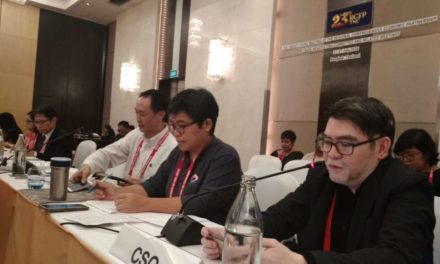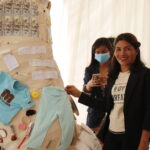As someone who has been watching closely the agricultural negotiations at the WTO for some time, I am still horrified at the arrogance of the United States and the hypocrisy of the European Union, as well as deeply frustrated at the huge power imbalances between the big players and the South. But more than even that, I am angry at the apathy of developing country governments, who in fact realise that 15 years of structural adjustment and WTO has brought greater poverty and destruction to their people, but continue to take only small and timid steps at the WTO to assert their rights. They remain blinded by the neo-liberal doctrine preached daily to them, and paralysed by the tight negotiating space they lock themselves into as a result of trying to ensure that they do not ‘anger the gods’ and put at risk any preferential trading arrangements and other ‘favours’ such as food aid, technical assistance or support in the political / security arena. For all these reasons, developing countries open themselves up to being bullied into compromises or submission.
Of course there have been some successes in the past two years – at Seattle, at Libreville, even at the Least Developed Countries (LDC) conference in Brussels, where developing countries continued to state a resounding ‘no’ to a new round. But scratch the surface and for many countries this resistance is not in fact as strong as it appears – and certainly needs — to be. The crises in developing countries – of poverty, food insecurity, precarious livelihoods and, with these, the loss of human dignity, deserves a NO a hundred times the strength of what is being muttered by governments in Geneva.
POSITIONS TAKEN IN THE MAY AGRICULTURE SPECIAL SESSION
In the latest agricultural talks at the WTO from 21-23 of May, three topics were on the table – tariffs, tariff rate quotas and the ‘Amber Box’.
All three areas are deeply problematic. The commitments undertaken by developing countries in these areas are antithetical to the needs of an increasingly impoverished agricultural sector. At the same time, the loopholes in these areas which are used (and abused) by the developed countries must be challenged and stopped, otherwise the rules of agricultural trade will continue to bestow special treatment to the developed rather than developing countries.
To make matters worse, the US and the EU act only on the narrow interests of their agribusiness corporations. In effect, they preach liberalisation to developing countries but continue heavy protection of their own markets.
Take the US. In this meeting, the US had the gall to make the following proposals: First, that the domestic supports provided to developing countries in the Agreement on Agriculture on input and investment subsidies (Article 6.2) should be tightened. Article 6.2 states that developing country members can provide ‘agricultural input subsidies generally available to low-income or resource-poor producers…’ The US wants to ensure that developing countries’ use of such subsidies are strictly targeted at low-income, resource-poor producers.
And second, they asked that tariff rates in these negotiations be cut from the applied rates rather than from the bound rates. Taking the Agreement in this direction would further narrow the rights accorded to developing countries. At the same time, the US displays its arrogance by asking for expansion of the Green Box of domestic supports (which they use and which are not subject to any limits).
The EU is also taking a position that would allow it to continue its huge trade-distorting subsidies. Although the EU is saying that it will reduce its export subsidies, it is fighting for these to be reduced only slowly. At the same time, it is retaining other types of domestic supports which contribute to dumping, such as the Blue Box (production limiting programmes) and the Green Box.
Japan took a tough though sensible negotiating position on the issue of tariffs. It asserted that countries should have the space to determine their tariff levels according to their internal problems and needs. This position is in accordance to their policy of protecting rice farmers to retain at least some level of self-sufficiency in rice, although domestic rice production is extremely expensive. Too many countries today are made subservient to the US and EU because of their food needs. The Japanese know this too well and are wisely refusing to trade their political sovereignty in return for rice.
On the issue of tariffs, many developing countries such as India, as well as the ASEAN countries, took the position that until subsidies of the OECD countries are reduced, they would not like to commit themselves to lowering of tariffs.
Other suggestions were also made on how to deal more fairly in the areas of tariff rate quotas and the Amber Box. For example, some members of the Like Minded Group (an informal grouping of developing countries which includes India, Pakistan, Dominican Republic, Cuba and Uganda) highlighted the many problems and loopholes used to circumvent commitments in the Amber Box and the need for these to be redressed.
While these are good suggestions, they do not go far enough in terms of comprehensively addressing the way the industrialised countries are abusing the system of subsidy ‘boxes’ in the Agreement. (Some countries last year had put forward a further position calling for all subsidy boxes to be collapsed into a single box and for support levels to be brought down to a common maximum percentage).
The voices of developing countries also continue to be subdued, in comparison to their developed country counterparts, as well as subdued in comparison with the urgency of the agricultural crises in so many developing countries today. While Australia, EC and Japan put papers on the table during (actually, ‘non-papers’ as the meeting had taken place in informal mode), there were no papers from developing countries on specific issues and only one general paper on Special and Differential Treatment. Inputs were made only orally. This was disappointing given that no records will be made of this informal meeting apart from the non-papers presented.
Even this informal negotiating process needs to be questioned. The session last May, the coming July Special Session as well as part of the September session will operate in informal mode. The practice of informal sessions is not new to the WTO, and the reason given is that it allows countries to have discussions ‘off the record’.
On the side, however, a couple of government delegates have questioned the wisdom of this. As one delegate succinctly put it, there were no records of the Uruguay Round negotiations. This has led to problems today, with dispute panels taking it upon themselves to interpret ambiguities, often to developing countries’ disadvantage. It would therefore be in the interest of developing countries to have these sessions on record.
US: ARROGANT BULLY IN NEGOTIATIONS
The audacity of the US’s position on tightening domestic supports falling under Special and Differential Treatment is clearly illustrated when one looks at current levels of support to the US farm sector and the billions that are being set aside to continue this support right through the coming decade. Direct payments to US farmers have jumped from 4.6 billion in 1996, to over 32.3 billion in the 2001 (Fischler, Speech at Congressional Dinner, 17 May 2001). The bulk of these payments fall under the Green Box which is not limited and which the US wants expanded. The pretext is that these payments are non-trade distorting since they are not tied to production levels.
This is not all. An additional 79 billion has been allocated for 2001-2011 to compensate farmers in the form of counter-cyclical programmes (that is, when farm prices collapse), conservation, as well as export promotion programmes (Inside US Trade, 25 May 2001). The Agreement on Agriculture rules contain so many loopholes that, according to the US House Agriculture Committee which is developing the new farm bill, these payments will be tailored to fit the present rules of the Agreement on Agriculture.
In contrast, developing countries have little or no financial resources to support farmers. In fact, the agricultural sector in developing countries is taxed rather than subsidised. Food prices are often kept low in order to subsidise the industrial sector and appease the urban population.
Sixty-one out of 71 developing countries in 1996 notified that they provided no domestic supports which are subject to reduction (Amber Box supports). And only thirteen of 71 developing countries notified that they provided investment and input supports that fall under Article 6.2 which the US is now asking to be tightened. And for all thirteen members, the level of these supports is between 0-5 per cent of their agricultural production (WTO, 1996, G/AG/AGST/Vols 1-3).
The corridor talk in Geneva is that the US is putting pressure on some developing countries. For those that currently provide input subsidies, it is not always administratively possible for them to ensure that the subsidies only go to small farmers and it is likely that a very small percentage goes to the bigger farms. The US is querying this and wants developing countries’ input subsidies to be notified as Amber Box payments is they are not be accurately targeted.
US subsidises up to 25 – 30 per cent of its agricultural production and the OECD estimates US’ Producer Support Estimate to be 26 per cent of production in 2000. Developing countries’ subsidies are unlikely to even reach 5 per cent of their production value, yet the US is preaching to developing countries about following the Agreement on Agriculture rules more strictly.
ON CUTTING TARIFFS FROM THE APPLIED RATES
The US position on tariffs is that tariff levels in the coming negotiations should be cut from the applied tariff rates, rather than the bound rates. (At the end of the Uruguay Round, members had to fix or bind their tariff levels in agricultural products. However, in practice, developing countries, often due to pressures by World Bank or IMF conditionalities, have used tariff rates that are much lower than the levels bound in the WTO. These are the applied rates.)
According to one developing country delegate, never in the history of the GATT / WTO have tariff rates been cut from the applied levels.
FAO studies on the effect of the Agreement on Agriculture in developing countries have shown that imports have surged into developing country markets due to the lower tariff levels resulting from both structural adjustment and WTO policies. While exports have increased, the amounts have been too small to compensate for the flood of imports. The result has been that poverty has been on the rise in the rural sector as small farmers are displaced.
Developing countries who either voluntarily chose to, or are under pressure by the big players to keep their tariffs way below the bound levels, see that in these negotiations reduction of tariffs from the higher bound level is, as a government delegate says, ‘the only real bargaining chip we have. The US is clearly bent on diluting this’.
According to observers in Geneva, Washington’s main area of interest in the present WTO negotiations are centred on securing more market access in agriculture. The agribusiness lobbyists are currently amongst the loudest in Washington. This is one of the reasons why the US remains unenthusiastic about the inclusion of new issues such as competition and investment. Agriculture is already in the built-in agenda and will be negotiated regardless of whether or not a new round is launched. Furthermore, to have new issues, they may have to address the current imbalances in the WTO package of agreements – this could also include the agriculture agreement – when they are more interested in maintaining a strong offensive position in this area.
EU’S MUTATED MULTIFUNCTIONALITY
While the US is infamous for its arrogance, the EU is more sophisticated and indirect. EU feigns concern for developing countries as well as plays up to its own domestic constituency by singing the multifunctionality anthem. In reality, there is nothing environmentally sustainable about the Common Agricultural Policy (CAP). Environmental programmes are like window-dressing for the overall CAP. On a recent visit to a farm in the Netherlands, I learnt that Dutch farmers are given some additional payments for the number of flowers they have on the farm, as well as the number of birds or birds nests. They are also compensated when they have ‘natural’ features on their property (such as man-made ponds). Yet these EU subsidies go to farmers who farm industrially (even as they include ‘natural’ features). There continues to be high usage of pesticides and chemical fertilisers and while subsidy payments encourage crop variety, monoculture farm methods are nevertheless employed. There is no expectation that this will change. Farms in the EU are becoming more like US farms. They are highly mechanised due to their size, which makes it impossible for the EU to engage in farming that is truly environmentally sustainable and which uses multi-cropping methods rather than monocultures.
In the end, EU multifunctional agriculture continues to be environmentally damaging internally. Externally, it has the effect of dumping food at lower costs in developing countries, displacing small farmers, thus destroying developing countries’ multifunctionality. For the EU, agriculture production, even at high costs, is necessary to keep their politically powerful farm lobby appeased. But in addition, it makes EU food self-sufficient, and hence independent. It furthermore gives the EU political leverage over countries dependent on them for food aid or cheap food.
Indeed, the EU is so bent on maintaining their domestic supports and even export subsidies that in a recent address, EU Agriculture Commissioner Fischler stated that ‘tariffs are the most trade-distorting feature in agriculture, followed by internal domestic support, and then export subsidies’ (Inside US Trade 1 June 2001)!
JAPAN’S CONTROVERSIAL POSITION
In the recent agricultural discussions, Japan has been paraded as the chief recalcitrant – a trophy that used to belong to the EU. Japan’s position on protecting their agricultural sector (especially rice) through tariffs and their stubborn insistence on continuing their high levels of support has raised the ire of many. As a result, countries, such as those promoting liberalisation in the Cairns group, feel that, in comparison, the EU’s more tempered position is much more palatable.
It is ironic that Japan’s position has been seen as so threatening since Japan itself does not export agricultural products. Apart from protecting their internal market, their subsidies do not bring about the undesirable effect of undercutting other producers in the world market.
Unfortunately, the broader picture is that Japan is closely allied with the EU – both in agriculture as well as their twin partnership in pushing for a broad round of negotiations. The Japanese position on the continuation of subsidies has the effect of lending weight to the EU’s position, which contributes to dumping. As one delegate puts it, the ‘EU’s work is being done by Japan, while the EU just sits back’.
DEVELOPING COUNTRIES’ WEAKNESSES
In and of itself, however, the Japanese position on tariffs should in fact be widely encouraged. Countries should, as Japan promotes, have the sovereign right to determine what comes into their borders and not subordinate or enslave their national objectives and interests to trade objectives.
However, the Japanese position on subsidies is flawed in that they do not make a distinction between supports that increase domestic production for domestic consumption, and supports that directly or indirectly subsidise exports. (The present Green Box criteria, that supports should be ‘non-trade distorting’ is much too vague.) US and EU subsidies should be viewed differently from Japan’s since they are big exporters.
Why are developing countries, unlike Japan, hesitant to protect their markets despite the dismal results of agricultural liberalisation through structural adjustment and WTO?
DEVELOPING COUNTRIES THINK THEY HAVE DIFFERENT INTERESTS
Developing countries are divided. Some belong to the Cairns Group of exporting countries (although the Philippines, for example, is in the group but has been a net importer since 1996). Others fall under the net food importing camp, and others, such as the Like Minded Group, are attempting to level the playing field through promoting stronger special and differential treatment.
The process of agricultural liberalisation in developing countries, though, for all groups has been alike, and the problems too, which have earlier been spelt out, are almost identical. Indeed, the number of developing countries informally joining the ranks of net-food importers is increasing. Even the big producers, like Argentina and Brazil are unable to deal with the surplus labour displaced from the agricultural sector.
There are broadly two interrelated reasons why developing countries positions have been so weak.
First, most developing countries have bought the promises of market access. Converting small, sustainable subsistence farms to larger export oriented farms seems to be an attractive notion, and a step towards a western constructed version of ‘growth’ and ‘development’.
Second, they have already or are currently being forced to liberalise. This could be through World Bank and IMF, through conditionalities in the African Growth Opportunity Act with the US, even through the HIPC Initiative (World Bank’s debt reduction programme which was declared by ECLAC Secretary general Jose Antonio Ocampo ‘the most conditional programme in history"). Take a small country like Bolivia, for example. It is no accident that although it has a rural crisis on its hands due to cheap agricultural imports, the country is one of the loudest proponents of liberalisation. Its bound tariff rates are 40 per cent. But their applied rates, thanks to the IMF and World Bank, are only 10 per cent and they provide no domestic supports to their farmers. Given this situation, they are now using their free market status to attempt to exert pressure on the big players to also liberalise, in the hope that some benefits will begin to flow.
Other developing countries may not have liberalised as much as Bolivia. Nevertheless, through dependence – politically, or economically – on the US or EU or both, they fight, but in a subdued way. As former President Clinton said, the key is to find out the biggest fear of the country you are negotiating with. Washington does not hesitate to maximise their leverage and play on developing countries’ fears and dependence to get what they want.
IS THERE ANY HOPE?
Maybe. But certainly not before developing country governments realise a few things:
1) The market access bait is a sham. If all countries (including the US and the EU) are looking to get more market access, it is impossible, given the limited markets available, that all parties will get what they want. There will be winners and losers, and more losers than winners. Some developing countries may get some additional access, but in return, they give away more than they receive in terms of their own domestic markets. It seems that in the mad scramble for ‘market access’, developing country governments have forgotten that they also have internal markets which they will have to trade off if they want more liberalisation.
2) Our thinking about economic development needs to be deconstructed and reconstructed. The largely Western-constructed idea of development, that is obsessed with GDP levels, increasing consumption and a fetish for exports, is inherently unsustainable. Export oriented economic growth depends on extracting and often depleting limited resources – environmental or human – converting these to products or services to be sold. In an increasingly competitive economic environment, these products are usually sold far below their real costs. For example, export oriented agriculture is turning once environmentally sustainable small farms to large industrial farms which rely of monocultures and heavy doses of chemical inputs. The output is sold off cheaply. However, in its wake, many countries are left with depleted farmlands that are no longer productive, as well as disastrous climatic conditions.
Developing countries need to come up with their own constructions of development and face up squarely to the fact that 15 years of structural adjustment, five years of WTO, and recklessly enforced liberalisation has brought destruction and huge inequity, rather than equitable growth for their people.
3) It is true that our world is increasingly integrated and interdependent. We cannot halt the progress of information and communication technologies. However, developing countries need to be smart about the terms of engagement. Over-dependence on bigger powers for food or other favours is unlikely to put a country in a strategically strong position. This means developing and strengthening our own internal economies rather than expecting an outward-oriented economic policy to lead us to economic growth. Strategic engagement essentially means that we engage only when we have attained a sufficient level of competitiveness to survive opening our markets.
Building and strengthening our internal domestic economies – both in agriculture as well as in the industrial sectors — would place developing countries in a much stronger negotiating position at the WTO. It is a long and hard road but the alternative is what we have today –the increasing poverty-concentration and wealth-concentration — except in larger doses.
* Aileen Kwa is a Research Associate with Focus on the Global South. She is currently based in Geneva. She is also the author of ‘Guide to the Agreement on Agriculture: Technicalities and Trade Tricks Explained’, and ‘The European Union and Developing Countries’ Non-trade Concerns: An Uneasy Alliance?’ These are available at www.focusweb.org








